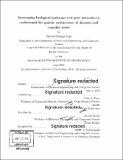| dc.contributor.advisor | Alkes L. Price. | en_US |
| dc.contributor.author | Kim, Samuel Sungil. | en_US |
| dc.contributor.other | Massachusetts Institute of Technology. Department of Electrical Engineering and Computer Science. | en_US |
| dc.date.accessioned | 2019-10-11T22:11:22Z | |
| dc.date.available | 2019-10-11T22:11:22Z | |
| dc.date.copyright | 2019 | en_US |
| dc.date.issued | 2019 | en_US |
| dc.identifier.uri | https://hdl.handle.net/1721.1/122548 | |
| dc.description | Thesis: S.M., Massachusetts Institute of Technology, Department of Electrical Engineering and Computer Science, 2019 | en_US |
| dc.description | Cataloged from PDF version of thesis. | en_US |
| dc.description | Includes bibliographical references (pages 73-82). | en_US |
| dc.description.abstract | Recent studies have highlighted the role of biological pathways and gene networks in disease biology. In this thesis, we formally assess (1) the contribution of disease-associated gene pathways to disease heritability, (2) the contribution of genes with high network connectivity in known gene networks to disease heritability, and (3) the contribution of genes with high network connectivity to disease-associated gene pathways to disease heritability. We constructed a broad set of pathway, network, and pathway+network annotations and applied stratified LD score regression to 42 independent diseases and complex traits (average N=323K) to identify enriched annotations. We demonstrate gene network connectivity is highly informative for disease architectures, but the information in gene networks may be subsumed by regulatory annotations, such that accounting for known annotations is critical to robust inference of biological mechanisms. | en_US |
| dc.description.statementofresponsibility | by Samuel Sungil Kim. | en_US |
| dc.format.extent | 82 pages | en_US |
| dc.language.iso | eng | en_US |
| dc.publisher | Massachusetts Institute of Technology | en_US |
| dc.rights | MIT theses are protected by copyright. They may be viewed, downloaded, or printed from this source but further reproduction or distribution in any format is prohibited without written permission. | en_US |
| dc.rights.uri | http://dspace.mit.edu/handle/1721.1/7582 | en_US |
| dc.subject | Electrical Engineering and Computer Science. | en_US |
| dc.title | Leveraging biological pathways and gene networks to understand the genetic architecture of diseases and complex traits | en_US |
| dc.type | Thesis | en_US |
| dc.description.degree | S.M. | en_US |
| dc.contributor.department | Massachusetts Institute of Technology. Department of Electrical Engineering and Computer Science | en_US |
| dc.identifier.oclc | 1122565145 | en_US |
| dc.description.collection | S.M. Massachusetts Institute of Technology, Department of Electrical Engineering and Computer Science | en_US |
| dspace.imported | 2019-10-11T22:11:21Z | en_US |
| mit.thesis.degree | Master | en_US |
| mit.thesis.department | EECS | en_US |
